
The Delaware, Lackawanna and Western Railroad, also known as the DL&W or Lackawanna Railroad, was a U.S. Class 1 railroad that connected Buffalo, New York, and Hoboken, New Jersey, and by ferry with New York City, a distance of 395 miles (636 km). The railroad was incorporated in Pennsylvania in 1853, and created primarily to provide a means of transport of anthracite coal from the Coal Region in Northeast Pennsylvania to large coal markets in New York City. The railroad gradually expanded both east and west, and eventually linked Buffalo with New York City.

The Lackawanna Cut-Off was a rail line built by the Delaware, Lackawanna and Western Railroad (DL&W). Constructed from 1908 to 1911, the line was part of a 396-mile (637 km) main line between Hoboken, New Jersey, and Buffalo, New York. It ran west for 28.45 miles (45.79 km) from Port Morris Junction in Port Morris, New Jersey, near the south end of Lake Hopatcong about 45 miles (72 km) west-northwest of New York City, to Slateford Junction in Slateford, Pennsylvania near the Delaware Water Gap.

Lake Hopatcong is a commuter railroad station for New Jersey Transit. The station, located in the community of Landing in Roxbury Township, Morris County, New Jersey, United States, serves trains for the Montclair-Boonton Line and Morristown Line at peak hours and on holiday weekends. Service from Lake Hopatcong is provided to/from Hackettstown to New York Penn Station and Hoboken Terminal. The stop is located on the tracks below Landing Road next to the eponymous Lake Hopatcong. The station consists of one active platform with shelter, and an abandoned side platform. There is no accessibility for handicapped people.

Roseville Avenue was a transfer station on New Jersey Transit's Morris & Essex Lines in Newark, New Jersey, United States. The station was built by the Delaware, Lackawanna and Western Railroad in 1903 as part of a project to lower the tracks below the road surface to eliminate grade crossings. It serviced Newark's Roseville neighborhood. It once had two tracks on the Lackawanna mainline and two low-wall platforms, with an additional platform along the Montclair Branch. The station remained in service during most of the 20th century, until New Jersey Transit closed the station on September 16, 1984.
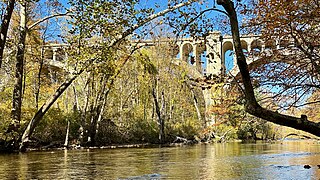
The Paulinskill Viaduct, also known as the Hainesburg Viaduct, is a reinforced concrete railroad bridge that crosses the Paulins Kill in Knowlton Township, New Jersey. When completed in 1910, it was the largest reinforced concrete structure in the world.

Port Morris Junction is the railroad connection between NJ Transit's Montclair-Boonton Line and the Lackawanna Cut-Off. Opened in 1911 by the Lackawanna Railroad, it is in the Port Morris, New Jersey section of Roxbury Township, New Jersey, south of Lake Hopatcong.

Roseville Tunnel is a 1,024-foot (312 m) two-track railroad tunnel on the Lackawanna Cut-Off in Byram Township, Sussex County, New Jersey. The tunnel is on a straight section of railroad between mileposts 51.6 and 51.8 (83 km), about 6 miles (9.7 km) north by northwest of Port Morris Junction. Operated for freight and passenger service from 1911 to 1979, it is undergoing work intended to return it to passenger service by 2026.

The Pequest Fill is a three-mile (4.8 km) railroad embankment in northwestern New Jersey completed in 1911 by the Delaware, Lackawanna and Western Railroad. Part of the Lackawanna Cut-Off, it was touted as the largest fill and the highest embankment ever built for a railroad.
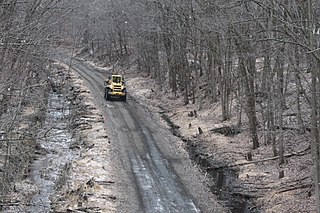
McMickle Cut is the longest cut on the Lackawanna Cut-Off railroad line in northwest New Jersey. It was built between 1908 and 1911 by contractor Timothy Burke between mileposts 47.1 and 48.1 where Stanhope and Byram Township meet. Some 600,000 cubic yards of material was removed by dynamite and other methods to make the cut, which is 1.04 miles long, has an average depth of 29 feet, and a maximum depth of 54 feet.

Waltz & Reece Cut is the deepest cut on the Lackawanna Cut-Off railroad line in northwest New Jersey. The cut is 0.68 miles (1.09 km) long, has an average depth of 37 feet (11 m), and a maximum depth of 114 feet (35 m).
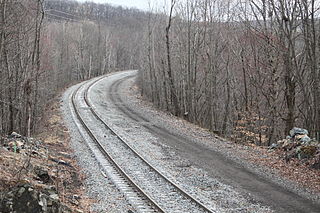
Bradbury Fill is one of the embankments on the Lackawanna Cut-Off railroad line in northwest New Jersey. It was built from 1908 to 1911 by Waltz & Reece Construction Company. It sits between mileposts 49.1 and 49.8 in Byram Township, just west of Waltz & Reece Cut and east of Lubber Run Fill.

Lubber Run Fill is a fill on the Lackawanna Cut-Off railroad line in northwest New Jersey. Located between mileposts 50.1 and 50.5 in Byram Township, it was built between 1908 and 1911 by contractor Waltz & Reece Construction Company. It is 0.40 miles (0.64 km) long, has an average height of 64 feet, and a maximum height of 98 feet. Most of its 720,000 cubic yards (550500 m3) of fill material was excavated from the surrounding low-lying area.

Wharton Fill is one of a number of fills (embankments) on the Lackawanna Cut-Off railroad line in northwest New Jersey. Located between mileposts 51.1 and 51.6 in Byram Township, the fill was constructed between 1908 and 1911 by contractor David W. Flickwir. The fill, which was created by placing fill material obtained by blasting with dynamite or other methods, is about 0.5 miles (0.64 km) long. Most of the material that was used to create Wharton Fill was excavated from the surrounding low-lying area through which Pumpkin Run runs; several of the borrow pits have since flooded and become ponds.

Colby Cut is one of a number of cuts on the Lackawanna Cut-Off railroad line in northwest New Jersey. Located between approximately mileposts 51.8 and 52.3 in Byram Township, the cut was constructed between 1908 and 1911 by contractor David W. Flickwir. The cut, which was created by removing fill material obtained by blasting with dynamite or other methods, is 0.53 miles (0.85 km) long, has an average depth of 45 feet (14 m), and a maximum depth of 110 feet (34 m). The cut was the result of the removal of 462,342 cubic yards of fill material within this section.

Greendell is one of three original railway stations built by the Delaware, Lackawanna & Western Railroad (DL&W) along its Lackawanna Cut-Off line in northwestern New Jersey. The station, which still stands in Green Township at milepost 57.61 on the Cut-Off, began operations on December 23, 1911, one day before the line itself opened and the first revenue train arrived.
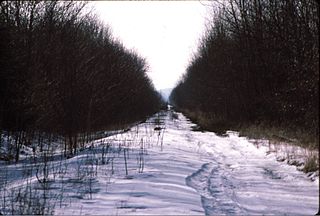
Andover is a planned New Jersey Transit passenger railroad station in Andover Township, in Sussex County, New Jersey, United States, providing service on its Lackawanna Cut-Off line. The line remains under construction. The station will be built at a site on Andover's Roseville Road, about 1.1 miles (1.8 km) from U.S. Route 206 and about 0.9 miles (1.4 km) from County Route 517. On the rail line, it will be located about 7.3 miles (11.7 km) west of Port Morris Junction.

Ramsey Fill is one of the fills (embankments) on the Lackawanna Cut-Off railroad line in northwest New Jersey. Located between miles 60.4 and 60.9 in Frelinghuysen Township, the fill was constructed between 1908 and 1911 by contractor Hyde, McFarlan & Burke. The .53-mile (0.85 km) fill has an average height of 21 feet, and a maximum height of 80 feet. It was created with 805,481 cubic yards (615,834 m3) of fill material obtained by blasting with dynamite or other methods.
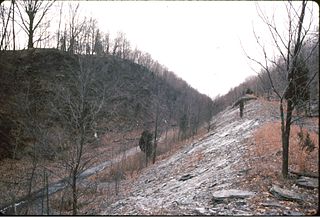
Armstrong Cut is one of the largest cuts on the Lackawanna Cut-Off railroad line in northwest New Jersey. Located between approximately mileposts 61.4 and 62.3 in Frelinghuysen Township, the cut was constructed between 1908 and 1911 by contractor Hyde, McFarlan & Burke. The cut, which was created by removing fill material obtained by blasting with dynamite or other methods, is 0.89 miles (1.43 km) long, has an average depth of 52 feet (16 m), and a maximum depth of 104 feet (32 m). The fill was created as a result of the removal of 852,000 cubic yards of fill material from this section of the right-of-way. Armstrong Cut is located on a tangent (straight) section of track, permitting 80 mph (130 km/h).
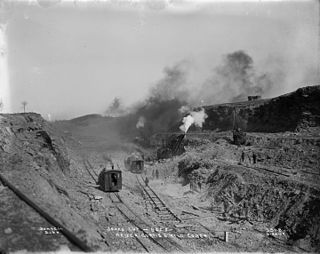
Jones Cut is one of the cuts on the Lackawanna Cut-Off railroad line in northwest New Jersey.

The Nicholson Cutoff is a rail line segment of the Sunbury Line rail line and formerly a rail line segment of the Delaware, Lackawanna and Western Railroad main line and the Delaware and Hudson Railway South Line. The Nicholson Cutoff and the rest of the Sunbury Line is owned by Norfolk Southern Railway.



















